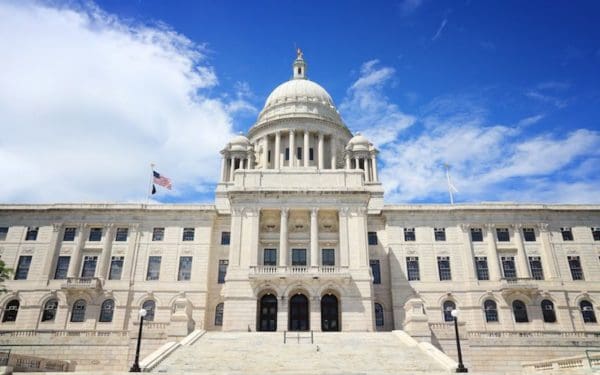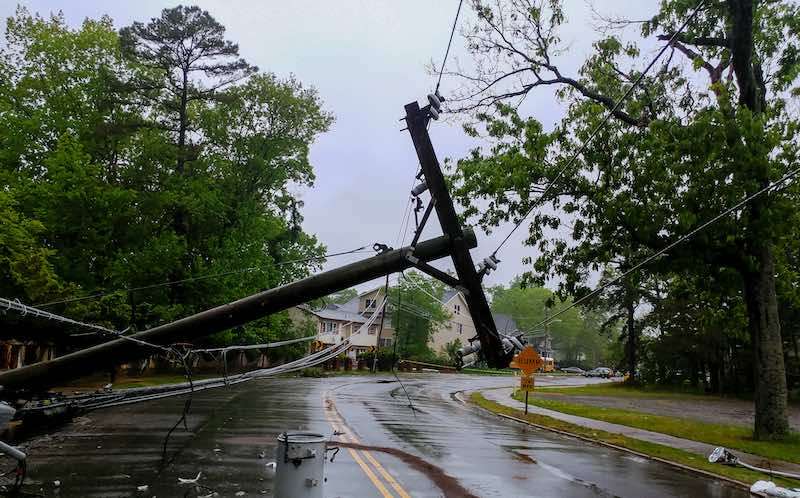
More frequent and powerful storms hit some communities harder than others. Photo: Shutterstock
Over the past five years, Holbrook has experienced more than three times as many electrical outages as the average Massachusetts town. That’s three times as many hours without heat, WiFi, or being able to turn on the lights.
Holbrook also happens to be an environmental justice community. Nearly 30% of residents are people of color, per capita income falls below the state median, and almost 14% of households speak a language other than English at home. Unfortunately, what we can learn from Holbrook sheds light on how skewed power outages tend to be. Environmental justice communities experience longer and more frequent electrical outages, and the impacts are more significant.
I recently analyzed the frequency, length, and location of power outages in Massachusetts and found that climate-related occurrences account for nearly one-third of them. In other words, extreme weather, such as storms and heat waves, are disrupting the grid. These events will only intensify with climate change.
This means that climate resilience practices, such as undergrounding power lines, are essential for functioning utilities. Massachusetts (and all New England) utility companies are responsible for preparing their electrical infrastructure for the effects of climate change and prioritizing those fixes in the communities that need them most.
Holbrook as a Microcosm of Electrical Outage Inequality
Located between Braintree and Brockton, Holbrook is a small town of 11,000 people, about 40 minutes from Boston. It’s easy to miss if you’re zooming along the busy highways that frame it, from Rte. 24 to the west, 93 to the north, and 3 to the east. Given its location, you’d expect it to have reliable electricity service. But that’s not the case.
Most of Holbrook is vulnerable to high heat and flooding. This fact, coupled with its status as an environmental justice community, contributes to its disproportionate experience of electrical outages. Environmental justice communities are less likely to have the financial resources to grapple with the lack of heat, refrigeration, or WiFi that results from an outage.
Through my research, I found that towns with environmental justice communities experience higher than average customer outage hours – 570 hours per outage – than the statewide average, which is just 505 hours. Holbrook’s average is even higher, at 1,650 hours per outage.
Average Total Customer Outage Hours From 2016–2021
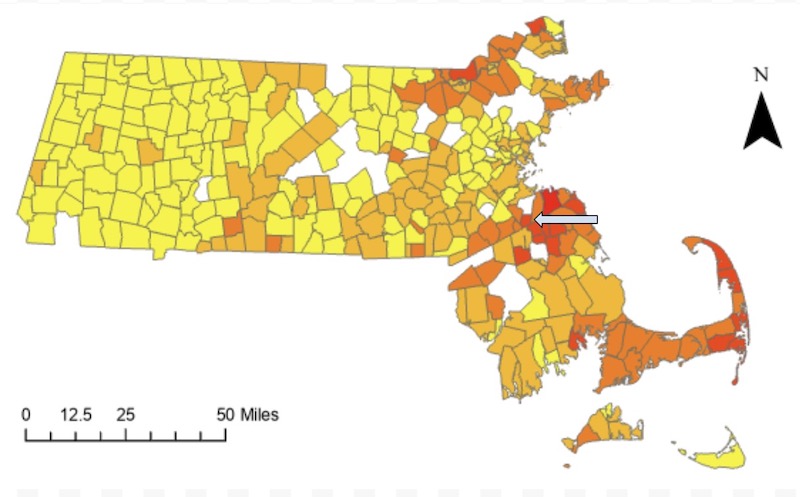
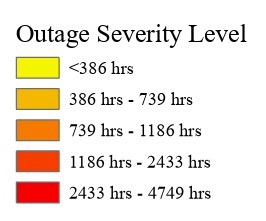
To conduct my research, I reviewed annual emergency response reports collected from utility companies by the Executive Office of Energy and Environmental Affairs in Massachusetts. Companies are required to report their outages every year alongside the reason for the outage and total customer outage hours. I analyzed 168,011 data points from 35 emergency response plans submitted by National Grid, Eversource, and Unitil between 2016 and 2021. I then compared the data with environmental justice communities and climate data such as rainfall and extreme heat to determine which towns are most vulnerable. Finally, I created maps that display the areas that should be prioritized for climate-resilient infrastructure.
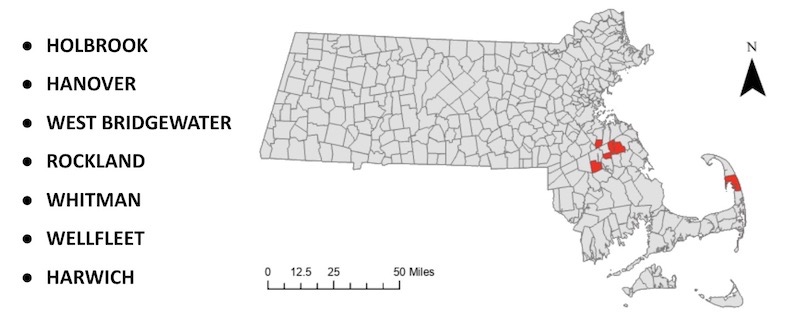
Outage Data Should Determine the Most Effective Climate-Resilient Interventions
Climate-related reasons caused almost 30% of all power outages in Massachusetts in the past five years. These include adverse environment and weather, lightning, and tree contact. Tree contact with electrical wires accounted for 59% of those climate-related outages.
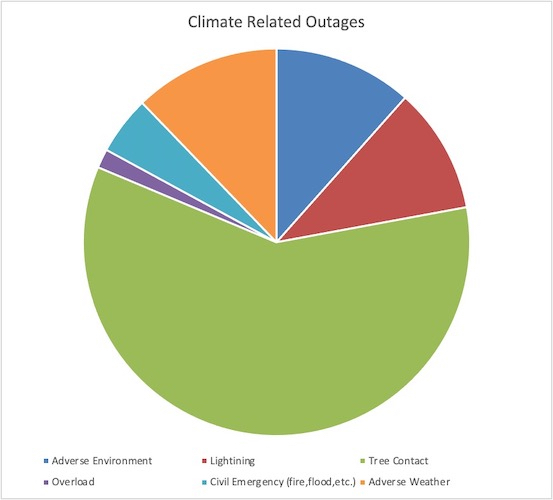
Given how frequently downed trees knock out power, utility companies should consider replacing overhead power lines with underground cables. Granted, this fix can be expensive, but prioritizing the towns most vulnerable to power outages will reduce costs while maximizing effectiveness. Vegetation management can also reduce tree contact with power lines.
It’s important to remember, however, that trees also provide essential benefits such as keeping neighborhoods cool – a critical factor with our increasingly long and dangerous heat waves. Maintaining the benefits of a leafy neighborhood must be balanced with the need to protect power lines.
Utility companies hold a responsibility to do more research on electrical outages. I found the data in the emergency response reports unorganized and difficult to interpret. It also seems that my research project has been the only attempt at analyzing this data. But this type of research is imperative for evaluating future climate-resilience interventions.
Extreme Weather Is Growing More Frequent and Intense
New England is warming faster than any other area in the United States, and we are seeing electrical disruption as a result. In late December, a winter storm blew through the region and left 160,000 customers in New England without power. Heat waves like the one we experienced in the summer of 2022, when Boston temperatures tipped over 90 degrees for 17 days in a row, will become the norm.
We will also see warmer temperatures at other times of the year. A record heat wave hit New England in November 2022 when states saw some days with temperatures reaching the high 70s.
Warmer temperatures, more frequent and intense storms, extended heat waves – these all place a higher burden on the electrical system. As climate change progresses, storms and other extreme weather will also increase. Our utility systems need to be ready. They’re not.
We Must Pressure Utilities to Prepare their Infrastructure for Climate Impacts
Climate change means more than just increased strain on utilities. Threats like sea level rise and severe storms can flood and damage utility infrastructure. New England utility companies know their infrastructure is not prepared for climate change. Currently, the Massachusetts Department of Public Utilities does not require utility companies to create a climate resilience plan. That means that every time a storm or heat wave comes around, unprepared utility companies pass along the costs of repairing damaged infrastructure to us, the customers.
In the end, those who pay the most are people living in environmental justice communities like Holbrook. They pay higher utility bills while living with more service interruptions, too.
CLF is pushing for utilities to do more research on electrical outages. They must prioritize the most vulnerable communities for investment and prepare their electrical infrastructure for the extreme weather they know we’ll be experiencing in the future.



